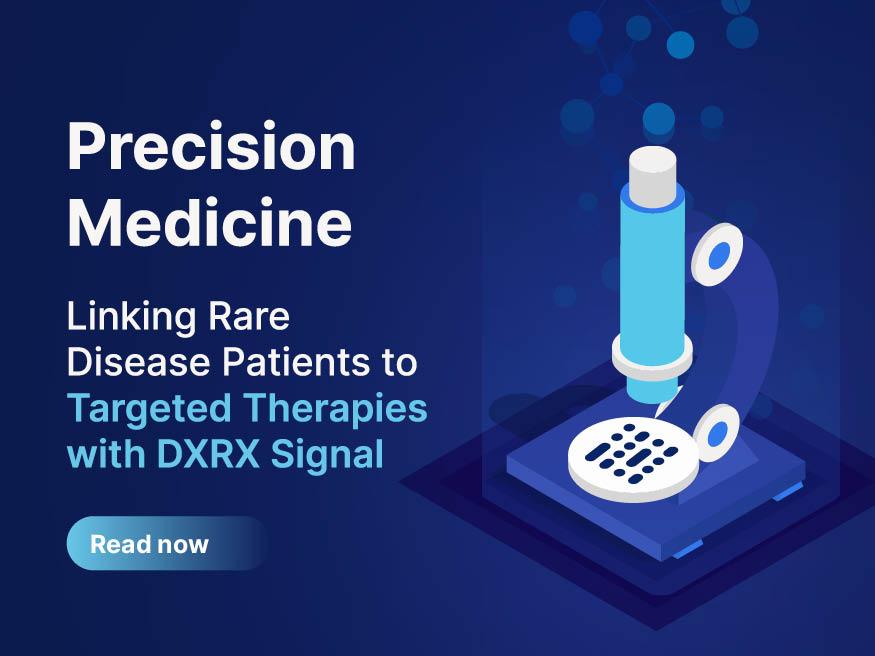Precision Medicine: Linking Rare Disease Patients to Targeted Therapies with DXRX Signal
When we think of rare diseases, we associate them with a small percentage of affected people. While the number of patients within individual rare disease patient populations is generally small, when we look at the high number of patients currently diagnosed with a rare disease, this equates to nearly 1 in 10 Americans.
When we think of rare diseases, we associate them with a small percentage of affected people. While the number of patients within individual rare disease patient populations is generally small, when we look at the high number of patients currently diagnosed with a rare disease, this equates to nearly 1 in 10 Americans (30 million people)1. In this article, we will cover what rare diseases are, some of the challenges faced by those working to fight rare diseases, and Diaceutics’ recommended Solution for aiding in overcoming these key challenges.
Many rare diseases worsen over time and are life limiting, making a profound impact on the lives of patients and their families and friends. The patients that live with an unknown disease endure continued suffering and are often faced with costs associated with care and lost earnings whilst they search for a diagnosis. Despite their best efforts, it takes on average 4-5 years2 for practitioners or specialists to diagnose patients with a rare disease. Furthermore, a diagnosis does not always result in treatment as only 5% of rare diseases currently have an approved treatment option3. These patients rely on the work of pharma companies to dedicate investment towards delivering breakthrough diagnosis and treatment to this underserved patient group.
Many pharma companies actively seek to develop precision medicine therapies for rare diseases, and one of the main challenges they face is finding patients, initially to take part in clinical trials and again when the treatment is approved for use. Traditionally, there are several ways pharma companies have executed patient-finding strategies, such as working with centers of excellence, and implementing awareness and educational campaigns. These strategies require time and investment and can lead to a delay in appropriate patients receiving treatment.
To overcome this barrier, Diaceutics developed DXRX Signal to help pharma clients identify physicians with potentially eligible patients to enroll on a clinical trial or receive treatment. DXRX Signal delivers a retrospective or prospective daily, weekly, monthly or quarterly alert of a testing behavior to notify pharma when a specific physician (NPI) has a patient that has tested positive for their required biomarker, indicating they may be eligible for treatment or clinical trial enrolment. This enables pharma to engage the treating physician during the critical treatment decision-making window and match those patients to the appropriate targeted therapies.
How does it work?
Using data from >505 labs in the US that cover a wide range of conditions (including oncology, rare diseases, autoimmune, cardiovascular, and infectious diseases) and our Diagnostic Deductive Pathways (DDPs®) to analyze the data, DXRX Signal drills down into the specific molecular genotype of patients to identify positive test results from a particular patient cohort.
DXRX Signal has played a crucial role in pinpointing those elusive, potentially eligible patients – akin to finding a needle in a haystack. Our client case study exemplifies this: DXRX Signal was employed to locate patients with tumors of any origin with a rare oncogenic fusion for a clinical trial study. This project started with a DXRX Lab Segmentation deliverable and then subsequently used this data within DXRX Signal alerts. These alerts efficiently identified potentially eligible patients, enabling the client’s team to promptly engage physicians, enrol eligible patients in the trial, and provide them with the treatment they rightfully deserve.
In summation, rare diseases, although numerically less prevalent than other diseases, should not be ignored by pharma. Rare disease patients are deserving of the same attentions that are afforded to the more profitable therapies, and Diaceutics offer a solution to some of the significant challenges faced in rare disease drug development. By aiding in the quick identification of ‘needle in a haystack’ patients, DXRX Signal is a powerful tool to get patients the right test and the right treatment, no matter their disease.
Contact Us
1 National Center for Advancing Translational Sciences https://rarediseases.info.nih.gov/about
2 Marwaha, S., Knowles, J.W. & Ashley, E.A. A guide for the diagnosis of rare and undiagnosed disease: beyond the exome. Genome Med 14, 23 (2022). https://doi.org/10.1186/s13073-022-01026-w
3https://www.phrma.org/en/Media/Progress-in-Fighting-Rare-Diseases
